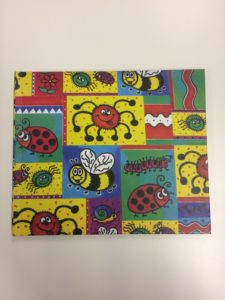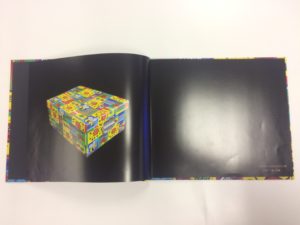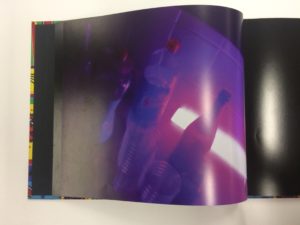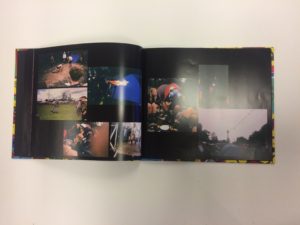In preparation for my Personal Study, I am analyzing by comparing and challenging the book productions of former students. The books generically contain photographs in relation to a particular theme which is organised by the school’s Photography Department, as well as entailing an essay based upon the comparison of two photographers and their methods. Key features that must be assessed within the student’s work is the concept, design and narrative of the book in order to comprehend the flow of a photography book, using the knowledge attained in order to understand in which direction I shall head toward.
The book was constructed two years ago by Jemma Hosegood with the title “The Memory Box”, although, this is not clear on the front of the book, a factor I discredit, however, this lack of immediate title does provide some level of ambiguity which is reflective of the discovery of her “Memory Box”. The first image within the book is of the memory box in question which is a colorful and childish object, with the same pattern that covers the outer layer of the book. The black lacquered image that forms the background of every page enhances and juxtaposes with the color on every page and giving more emphasis upon on the memories this photographer is attempting to share. As we move to the next page the image is on the right side of the double page spread and this time we see the contents of the book from an aerial position, like a bird’s eye view. By placing the image on the other side of the page, there is a degree of uncertainty which plays upon the unknown element of this box which pieces together and forms the basis of this project. The photographer reveals objects in the image which she further develops, for instance, the maternity image of the photographer as a baby. This innocence is contrasted with images which entail a more mature, adolescence insight into life as a teenager, for example the blurry photo of an empty bottle of alcohol at what is presumably a house party. The images are accompanied by colorful texts which gives the audience a sense of the photographer’s journey as she moves through her life’s development in a colorful array of images. There is a series of images on one particular double page spread which depict her time at a festival. Although the images are taken on what seems like a disposable camera which would compromise the quality of the image, the photographs are organised neatly despite their varied compositions. A common motif through this photographer’s book is the use of rhetorical questions which coincides with this sense of ambiguity, for example, on the double page spread full of her festival photographs, there is text stating “What have I forgotten?”. As we turn the page, we are reminded of the innocence of the child again which creates this sense of distortion in the photographer’s work, which accompanied with her hazy adolescent images gives me an impression of a confusion in identity. A crucial point to acknowledge is that the images of the baby orientated documents are carefully photographed in a clear manner which are juxtaposed with the blurred disposable camera images.





Overall, I believe this book is a photographic journey which the photographer hosts in order to depict how she started life as a clear and innocent character, however, as she has grown older and entered the adolescent stage of her life, she is struck by distortion whether this come through distortion is alcohol based or whether the photographer is revealing she is unaware of what direction she is now moving in other than the party/ festival scene which seems to unite her and friends rather than the maternal images which unify her and her mother.
The written element of the book is a comparative essay of the work of two photographers and how her work does and does not coincide with the formats discussed. The photographer discusses the work of the two photographers she is studying and suggests how their work is reflective of their own lives, creating this autobiographical sense which forms the basis of her own work. Jemma talks about how Phillip Toledano lost his sister at the very tender age of six and that after his parents had passed, he discovered a box full of images and belongings of his sister. From an outsider’s perspective, this photographers work is very similar to “The Memory Box” which would give Jemma a good platform to work off of as her project is based around the discovery of her own memory box.
